In order to view this feature, you must download the latest version of flash player here.

It is a scene from which many of us would naturally recoil, or at least avert our eyes: a grievously injured young man, fallen on a rough patch of earth; his open-mouthed and unseeing stare registering — who can know what? — horror or fear or shock; being tended desperately by two companions in what are the first moments of the final hours of his life.
It is a scene that plays out daily among American troops in Afghanistan and Iraq, but one that has largely been unseen by the American public in eight years of war.
On Friday, after a couple of weeks of intramural debate and over the objections of the young man’s father (supported by the defense secretary), The Associated Press released such a photograph, by Julie Jacobson.
It depicts Lance Cpl. Joshua M. Bernard, 21, of New Portland, Me., shortly after he was struck by a rocket-propelled grenade during a Taliban ambush of his squad last month in Dahaneh, Afghanistan. He lost one of his legs in the attack and died later at a Marine compound during surgery. To provide context for this deeply troubling image, the A.P. sent out a series of photos before and after the attack, a news article about the attack, an article about the decision to distribute the picture, excerpts from Ms. Jacobson’s journal and a video that she narrated.
“What it does is show — in a very unequivocal and direct fashion — the real consequences of war, involving in this case a U.S. Marine,” said Santiago Lyon, the director of photography at the A.P. “And that becomes very personal and very direct in some way, because we have a name, we have a home town, we have a shared nationality and we have, to a certain extent, a shared culture and some common values.
“So I think it really becomes a very immediate visual record of warfare that, in and of itself, is compelling, and that becomes more compelling because of its rarity.”
Mr. Lyon attributed that scarcity to the relatively small number of journalists embedded with military units throughout Iraq and Afghanistan, to the declining number of news organization that are in a position to embed their employees with troops overseas and to military rules forbidding the depiction of a casualty until the Defense Department has announced the service member’s name.
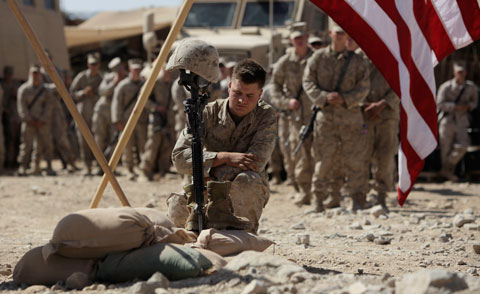 Julie Jacobson/Associated Press Cpl. Braxton Russell paid his respects to Corporal Bernard at a memorial service.
Julie Jacobson/Associated Press Cpl. Braxton Russell paid his respects to Corporal Bernard at a memorial service.Corporal Bernard’s death was widely reported. Indeed, Ms. Jacobson’s photograph of his memorial service has been widely seen. But it was not until this week that The Associated Press let it be known publicly that it had a picture taken shortly after the corporal was hit.
His father, John Bernard, a retired Marine first sergeant, was shown the picture and told the A.P. that “by distributing this photograph, we would be dishonoring the memory of his son,” Mr. Lyon said. (Mr. Bernard did not respond to a telephone inquiry left on Friday at his business. An audio interview has been posted on the Bloviating Hammerhead blog.)
On Thursday, Defense Secretary Robert M. Gates intervened personally. He contacted Tom Curley, the president of The Associated Press, to ask that the A.P. “honor the family’s request to not have the photos published, out of respect for their son,” said Maj. Shawn Turner, a Pentagon spokesman.
In a letter to Mr. Curley, Mr. Gates said: “Why your organization would purposefully defy the family’s wishes knowing full well that it will lead to yet more anguish is beyond me. Your lack of compassion and common sense in choosing to put this image of their maimed and stricken child on the front page of multiple American newspapers is appalling. The issue here is not law, policy or constitutional right — but judgment and common decency.”
The Associated Press, which had already sent out the pictures to member newspapers under an embargo prohibiting their publication until midnight, stood by its decision. “We thought the value of that image was to show the complexity, the sacrifice and the brutality of the war,” said John Daniszewski, a senior managing editor.
Not every news organization agreed. In Maine, The Portland Press Herald said pointedly on its Web site, “We believe that running the photo would be in poor taste and have chosen not to run it.” The Washington Post’s Web version of Ms. Jacobson’s slide show on Friday omitted the critical picture, although it later appeared on The Post’s site, along with an article noting that Post editors had “decided not to publish the image in the newspaper.”
The St. Petersburg Times featured the photo on its Web site. And The Commercial Appeal in Memphis carried Ms. Jacobson’s narrated slide show, which included the picture of the stricken corporal.
What remains to be seen is whether the publication of this picture has any effect on the broadening debate over American policy in Afghanistan, by conveying in such an awfully memorable fashion the price being paid by individual marines and soldiers.
Unusual as such images are, this is scarcely the first time the question has arisen whether the public is better served by seeing war in all its grisly manifestations or whether propriety and respect for the privacy of American families ought to trump the journalistic concern. Clark Hoyt, The Times’s public editor, discussed the issue a year ago in “The Painful Images of War.”
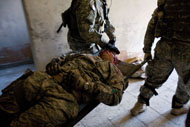 Staff Sgt. Hector Leija, mortally wounded, was carried to an armored vehicle in Baghdad in January 2007. Robert Nickelsberg of Getty Images took the picture for The Times.
Staff Sgt. Hector Leija, mortally wounded, was carried to an armored vehicle in Baghdad in January 2007. Robert Nickelsberg of Getty Images took the picture for The Times.One of the most painful was taken in 2007 by Robert Nickelsberg of Getty Images for The Times. Accompanying Damien Cave’s article, “‘Man Down’: When One Bullet Alters Everything,” it depicted Staff Sgt. Hector Leija after he had been shot in Baghdad. Gen. Raymond T. Odierno, who is now the top American commander in Iraq, criticized The Times in a letter, saying: “What is disturbing to me personally and, more important, to the family of the soldier depicted in the photograph and the video, is that the young man who so valiantly gave his life in the service of others was displayed for the entire world to see in the gravest condition and in such a fashion as to elicit horror at its sight. This photograph will be the last of this man that his family will ever see.”
In the current case, Mr. Lyon of the A.P. said there was a “healthy discussion” within the organization about distributing Ms. Jacobson’s photo. “The decision we came to was that — as a journalistic imperative — the need to tell this story overrode some of the other considerations,” he said. “Of course, we appreciate the anguish of the family of this marine. Of course, we appreciate the sacrifice that he made for his country. At the same time, there’s a compelling reason to show the real effects of this war. Sanitizing does everyone a disservice, in my view. Limiting casualty counts to numbers and names and nothing else; that’s a very incomplete picture of what’s going on.”
A.P. executives took pains to note that they had withheld the picture of the mortally wounded marine until after his burial in Maine and that they had contacted his family in advance. And Ms. Jacobson said she showed the image to other members of his squad. “None of them complained or grew angry about it,” she said in a journal entry that the A.P. transmitted.
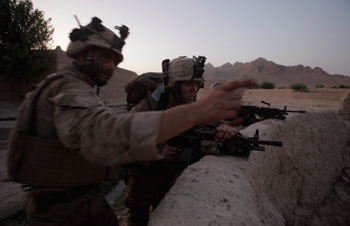 Julie Jacobson/Associated Press Corporal Russell, left, instructing a marine as they approached a pomegranate grove where the Taliban were believed to be.
Julie Jacobson/Associated Press Corporal Russell, left, instructing a marine as they approached a pomegranate grove where the Taliban were believed to be.The Associated Press made a point of saying that Ms. Jacobson, who was under fire herself, “took the picture from a distance with a long lens and did not interfere with Marines trying to assist Bernard.”
Mr. Lyon said, “We were very careful to respect the letter of the military embed rules.” In the case of the Second Marine Expeditionary Brigade in Afghanistan, they are: “Casualties may be covered by embedded media as long as the service member’s identity and unit identification is protected from disclosure until OASD-PA [Office of the Assistant Secretary of Defense, Public Affairs] has officially released the name. Photography from a respectful distance or from angles at which a casualty cannot be identified is permissible.”
Mr. Lyon said the somewhat blurry quality of Ms. Jacobson’s photo, its dimness and graininess, sufficiently masked the graphic nature of the injuries suffered by Corporal Bernard.
“Our duty is to inform, and sometimes that can be shocking,” he said. “But I think we fail in our duty to inform if we repulse the reader because the image is too graphic. If what comes from the picture is total disgust and revulsion, we have not succeeded.”
Michele McNally, an assistant managing editor of The New York Times, said she found the picture acceptable for publication. “It is newsworthy, and is a sensitive interpretation of the event,” she said. “It is not gratuitously graphic. This is what happens in war: people get mortally wounded and their comrades rush to help them.”
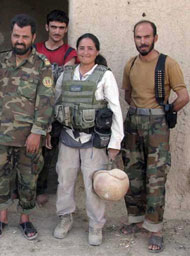 Associated Press Julie Jacobson with Afghan soldiers.
Associated Press Julie Jacobson with Afghan soldiers.Ms. Jacobson considered these and other questions in a journal entry written five days after the attack, which she subsequently distributed among friends and colleagues: “I shot images that day well aware that those images could very possibly never see the light of day. In fact I was sure of it. But I still found myself recording them. To ignore a moment like that simply because of a phrase in section 8, paragraph 1 of some 10-page form would have been wrong. I was recording his pending death, just as I had recorded his life moments before walking the point in the bazaar.” She continued:
Death is a part of life and most certainly a part of war. Isn’t that why we’re here? To document for now and for history the events of this war? We’d shot everything else thus far and even after, from feature images of a Marine talking on a SAT phone to his girlfriend, all the way to happy meetings between Marines and civilians. So shooting the image was not a question.
To publish or not is the question. The image is not the most technically sound, but his face is visible as are his wounds. Many factors come into play. There’s the form we signed agreeing to how and what we would cover while embedded. It says we can photograph casualties from a respectable distance and in such a way that the person is not identifiable. Then you think about the relatives and friends of Bernard. Would you, as a parent, want that image posted for all the world to see? Or even would you want to see how your son died? You’d probably want to remember him another way. Although, it was interesting to watch the Marines from his squad flip through the images from that day on my computer (they asked to see them). They did stop when they came to that moment. But none of them complained or grew angry about it. They understood that it was what it was. They understand, despite that he was their friend, it was the reality of things.
Then there’s the journalism side of things, which is what I am and why I’m here. We are allowed to report the name of the casualty as soon as next of kin has been notified. It is necessary and good to recognize those who die in times of war. But to me, a name on a piece of paper barely touches personalizing casualties. An image brings it home so much closer. An image personalizes that death and makes people see what it really means to have young men die in combat. It may be shocking to see, and while I’m not trying to force anything down anyone’s throat, I think it is necessary for people to see the good, the bad and the ugly in order to reflect upon ourselves as human beings.
It is necessary to be bothered from time to time. It is too easy to sit at Starbuck’s far away across the sea and read about the casualty and then move on without much of another thought about it. It’s not as easy to see an image of that casualty and not think about it. I never expect to change the world or stop war with one picture, but only hope that I make some people think beyond their comfort zones and hope that a few of them will be moved into some kind of action, be it joining a protest, or sending that care package they’ve put off for weeks, or writing that letter they keep meaning to write, or donating money to some worthy N.G.O., or just remembering to say I love you to someone at home. Something.
I believe that is why I decided to send the photo in to the N.Y. desk despite what the media rules of engagement said, to start some conversation about it and hope that it will move out there. It bothered me too much not to have at least some discussion about it. And with great respect and understanding to all the opposing arguments to publication, I feel that as journalists it is our social responsibility to record and publish such images. We have no restrictions to shoot or publish casualties from opposition forces, or even civilian casualties. Are those people less human than American or other NATO soldiers?
So, debate amongst yourselves or maybe just to yourself. Send me your thoughts if you like. Enlighten me if you disagree.
Lens seconds the request and welcomes your comments.


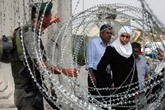 Pictures of the Day: Friday, Sept. 4
Pictures of the Day: Friday, Sept. 4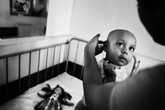 Showcase: Too Young
Showcase: Too Young
From 1 to 25 of 674 Comments
I applaud Ms. Jacobson and the Associated Press for making a stand on this issue. The only information we have really received on casualties from this war are little blurbs, names…and pictures of dead Taliban and civilians. It is imperative that the American people see images like this from time to time in order to spark the type of debate that we are now indeed having. Most of the comments I have seen around the web are deploring the AP for making this decision as they think it was to sell papers.Considering what the AP does and the fact that it was up to the individual paper to decide what to do, I find those arguments improper. I think once the shock wears off, people will begin to seriously debate our role in Afghanistan. Personally, I support our efforts there, but that is inconsequential. The AP acted with all respect in this situation. Contacting the family before making a decision was above and beyond any professional obligation that they had. Disrespecting the families wishes should not be held against the AP, it is their duty to faithfully report the news. It has been to long since the American people have actually gotten raw, unfiltered news, images, and stories. I don’t believe that the front pages should be plastered with pictures of American casualties, but it is important that we be reminded of the real costs of combat from time to time. Lest we forget that it has been over 100 years since we have experienced a war on our own soil. As a person who has many friends in the Marines currently serving and a brother who used to serve, I can understand why people are upset at the AP. If it were my brother, I could not bear to see that picture. I grieve with the family, and unlike so many men and women who are but a name attached to a rank in the paper every day, Cpl. Bernard will be on everyone’s minds for weeks to come. I truly hope that people understand that although this picture depicts a horrible end for a good Marine and a good person, it will foster debate that will allow changes to be made so that hopefully more Marines lives will be saved. As my brother once told me, when you are a Marine, you fight for other Marines, they are your brothers. It was so fitting to see Cpl. Bernard’s brother’s coming to his aid and grieving for him when he died. Thank you Cpl. Bernard for fighting for my friends in the Marines, for my brothers, and for giving your life and the image of your death to help America stay free.
— ZackThe bottom line on this, the father asked the pictures not be published. Out of respect for the fallen Marine and his family this should have been honored. My son was killed in Kirkuk, Iraq and just seeing his casket come off the plane was hard enough. I cannot imagine opening up a newspaper or watching the news and seeing my son as he took his last breath. How awful that the news cannot understand the emotional havic they can place on the family. Give the family’s of the fallen the choice and respect the decisions.
— Donna KuglicsThe form that was signed agreed that a casualty of war would not be identified. You chose to disregard that. The disrespect shown for this young man and his family is inexcusable. Your “responsibility as a journalist” includes respect and honor for individual persons. The military are not exempt from such honor and respect. Indeed they deserve much more than what you have shown. Shame on you.
[As reported in the post, the form says: “Casualties may be covered by embedded media as long as the service member’s identity and unit identification is protected from disclosure until OASD-PA [Office of the Assistant Secretary of Defense, Public Affairs] has officially released the name.” Corporal Bernard’s name had been released by the Pentagon. — Lens]
— Janet MarionActs such as this decision by AP to publicize the photograph of a dying Marine against his family’s wishes make me sick to my stomach. I can only hope that the decision makers at the Associated Press who decided to publicize the photo of Marine Corporal Bernard’s will someday have someone in their own family horribly injured and dying with someone taking photographs of their familymember and UPI, the New York times and all all of the major television networks will decide to post photos of their family member - against their wishes.
— Chris MageeI don’t fault the photographers who made the decision in the heat of the moment to photograph anything that may have been of help to the military and the U.S government. However, I have no respect left for the decision makers at Associated Press who when they had time to think about their decision at a later date and under the very freedom afforded to them by Corporal Bernard, The Marine Corp and the United States Government - sit in their air conditioned offices and ignore Corporal Bernard family’s wishes - after Corporal Bernard had died fighting for the very freedom afforded them to make what we can only hope are decent, respectful and moral decisions - something the decision makers at AP are clearly incapably of doing on their own. It makes me start to believe that the 1st ammendent is severly flawed and should be revoked
and everything to do with the War including all reports should put under the total control of our government.
Chris Magee
Why are photos of Iraqis and Afghanis ok to show and those of the U.S. military appalling? War is not picturesque. We sit on this side of the world supporting our troops without a faintest idea about what they’re going through. This picture is evidence of the truth and the truth is bitter. AP is doing their job, reporting the truth….something our news media could learn.
— John DoeDisgusting. Please take the photo off your site.
— CPCI think most of us know that war and combat is ugly and sad. For people who think war is a good and pleasant experience, I don’t think see this photo will change these people minds. Having a brother in the US Army and soon to be in a combat zone, I would hope that people would respect our family wishes. However, even the AP pulls cheap tricks like this to get people to view the content. I can’t think of one good reason these photos should be published. The photo did not shed new light on a event, it did not make the history more real. I think it goes only to show how business are in it for the money. If this was an AP reporter they would have not published the photo.
— DouglasJulie Jacobson should be ashamed of herself for taking this picture and allowing it to be published. It is disrespectful to the memory of the Marine and a side of the war that no one needs to see. Thank you for proving that the media is the scum of the earth. I hope Ms. Jacobson and the editors who approved the photos publishing can live with themselves.
— Christine RemillardAs the mother of two active duty servicemen I have to say I am appalled, saddened, repulsed by the photo. However, I don’t believe we should shield the American public from the realities of war. Why make it easier for the rest of the country to ignore what our children are sacrificing for them? Slapping a bumper sticker on your car is easy. Living with the heartache of an extended deployment or worse is hard. Very hard.
— Corina SilvaEverything should be documented. Everything should be published(like during Vietnam). No censorship!
— memThank you for publishing this photo. It helps those of us who are not on the scene to better understand the situaiton in a place few of us will ever see. The media’s purpose is to inform its readers, not to either shield them from or expose them to particular images and stories. Americans deserve a media who will report the truth, letting Americans to decide what to do with that information.
— Jim BeckhamIt is not the job of the media to honor or to dishonor US servicemen and women, but as it happens, this photo also places great honor on all three men pictured in the photo - for both their devotion to duty and sacrifice.
I concur with Secretary Gates. My heart goes out to the Marine’s family.
— Marty EverettYeah, but when did the AP ever publish photos of, for example, Saddam Hussein’s torture victims?
— Eliot NessI served as a medic in the military for 20 years and saw more gore and heartache than can be imagined.
I do not believe in putting a candy coating on war and protecting the average citizen’s delicate sensibilities because the subject matter isn’t pretty. War isn’t pretty!!! The public needs to know there are men and women dying for them, pretty or not. Censorship flies in the face of what every soldier fights for, that is freedom! Freedom to speak, freedom of the press, freedom to stand and be counted, pretty or not. Reality check folks, don’t make what we fought for null and void because it hurts your politically correct feelings.
— Dee ReichFirst and foremost, let me say that the only reason why I object is because the family pleaded for them not post it. There are American soldiers slain in theatre everyday! I was over there in 2003-2004 and war is ugly plain and simple. I feel like the everyday American has become numb to what is really going on over there. Wake up America!!!!! Just because the news would rather cover the latest celebrity instead of real news does not mean we have to forget. Maybe more of these photos should surface and then people would understand that when we come home we are not the same as when we left, and a “It’s good to see you buddy” feels a lot better than ” So, did you kill anyone over there?”. Just a little something to think about america.
— Jason TurnerI am completely against publishing this picture. I do agree we need to know what is happening, but the suffering caused by the picture to the family should be enough to keep AP from releasing this picture. If I was a soldier, I would not like a picture of my death on the front page for all to see. I would like a picture of me, alive, be it the official photo, or one of me patrolling to be published. I don’t want the people to see me dying. This is something personal, and my family should be spared of this situation. That is not the way to go for a soldier, as is the only thing peole will remember of me. Also, stop using the “we are showing the people what is really happening” lie. You, AP, are only trying to make a buck by selling someone else’s pain.
— CristinaI commend and thank Julie Jacobson for her invaluable work.
— u. saldinDear Julie,
As I sit and contemplate what my weekend plans are, I come across this photograph and this story. I am sick to my stomach. Is what I feel anger? Is it sorrow? Sorrow and grief for this child, who raised his hand and said he would defend his country.
I raised my hand and took the same oath when I was 19. I served my country (during peace time). I think back at what it meant to me then and what it means to me now.
Back then, I was nieve but thirsty for adventure, and yes, a proud young American. One of 13 females in a brigade of 250 males, I quickly learned what it meant to be a “soldier”. I had never (or never will) quite surpass the feeling of accomplishment, pride, and honor that I felt during my tenure. People still thank me to this day, I’m 43. I tell them, “no, don’t thank me, thank people like my brother, two tours in Iraq, and another tour this September to Kosovo. Thank all the people who are serving today. I had it “easy” compared to those who serve today.
I have seen photos of mortally wounded, and I ‘ve seen the video , heard the shots that were fired at the truck that my brother drove thru Fallujah. He brought back these photos and memories with him. All I could muster to say thru the shock was “Please don’t show this to Mom”. I said a silent prayer of thanks that my only brother was alive and back home with his family. My countless nightmares of images of his death could finally end.
I can’t ever imagine the pain and grief that Lance Corporal Bernard’s family is feeling. I offer my sincerest condolences, for this handsome young man’s sacrifice, his family’s sacrifice. The “what could have been” of his life. I’m sure he was a proud Marine. I truly feel we all have our purpose in this world. His life is one of many, lost to a war that we will forever debate,and time will tell what place it takes in history. May his family know that their sacrifice will not be forgotten. As for the photo, I must say, may I get this sick feeling until the last soldier comes home from war, to remind me of what it means to live in this country, and the price that is paid by every man and woman in uniform today. As far as whether I agree or disagree, I can only say thank you to the soldiers and families who serve, and thank you to the photographers and journalist who tell the truth from behind a lens, as painful as it may be. God Bless, stay safe.
— Edna AlonsoEdna Alonso
Laguna Hills, CA
I think the embedding of reporters should be discontinued. If reporters want to cover the war, they should do so at their own expense and at their own risk.
— Patrick FortnerPeople in this country have a tendency to glorify the act of war as well as the act of being a soldier. This is not a position or an event to be glorified, lives are lost daily, families are broken, dreams extinguished never to be again. The fact that so little of the bad side of war is reported on, photographed or known to the American public makes the event so much easier to stomach. Daily I see pictures of dead iraqis, afghanis and the like yet I dont see anyone raising an objection to this. A life is a life, he died doing what he signed up for, maybe for the money, maybe for patriotism only his family will know that. But in the end he died in the process of nation building in a war that was not necessary like most wars ever fought. For the American people to realize what is truly happening in this conflict and to realize the ugly ugly nature of the event this needs to be shown, to sugarcoat a war is a disservice to all involved.
— Dan ZI see nothing inappropriate about the publication of this photograph. This is the reality of war. Attempting to mislead the American public into thinking that war is anything else is inappropriate. This is truth.
— S. P.From my point of view, Gates’ letter’s closing hits the nail on the head - to paraphrase: “sure, you have the right to publish it, but would you please have the decency to hold it back given that the family’s expressed that wish?”
If I snapped a picture of your child getting murdered, would you want me to e-mail it to the media or just hand you the photo, master print/file and all? Sure, I could e-mail it to the media, but I can’t think many who know me would think much of me after doing it.
Why didin’t we or don’t we now dig out and print Kennedy’s ‘brains on the table’ photo or the ‘Apollo 1 astronauts charred remains in the capsule’ photos or…? Because, out of respect for Jackie, and the astronauts’ families, etc, we said, “yea, it’s bad enough, why rub it in?”
Why doesn’t a poor dead Marine and his family deserve any different?
— Michael CorcoranI for one feel for the family, but I think its important the public see these images. No one wants to see a person who fights for your country die, but its the truth, and as they say, the truth hurts.
Blood for Oil. 9/11 killed less than 4,000 people. How many innocents have we killed in revenge?
— Joe RA very well written, and insightful blog. Thank you for having the bravery to tackle this subject. As far as the nay sayers, I’m convinced that most of these people are the ones with their heads in the sand. This is the reality of war. This is life. This is death. The consequences and repercussions must be documented, and if possible, shown.
— davidAs a combat Marine and veteran of Iraq I know and have seen first hand the horrors and gruesomeness of war. I understand that America needs to be educated on what is happening a world away. But I believe for the AP to directly disrespect the wishes of the family of Lance Cpl. Joshua Bernard is completely uncalled for. They should have some sort of respect for the family and their wishes.
— LCpl AllanSemper Fidelis Lance Cpl. Joshua Bernard. Your sacrifices will not be forgotten by those whom have served or known you.
“In rememberance of those who have gone before, yet never returned.”